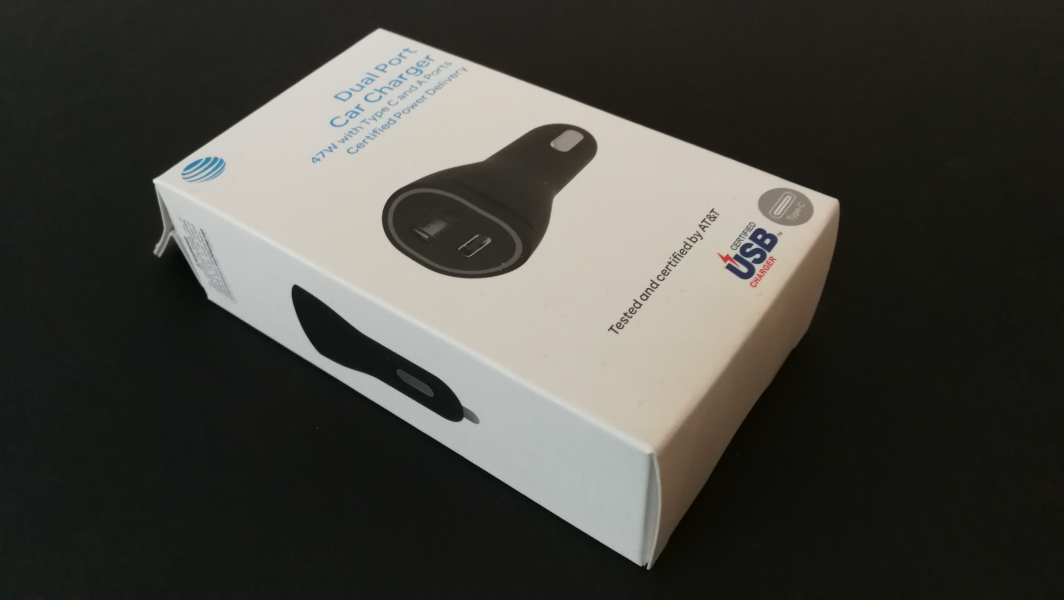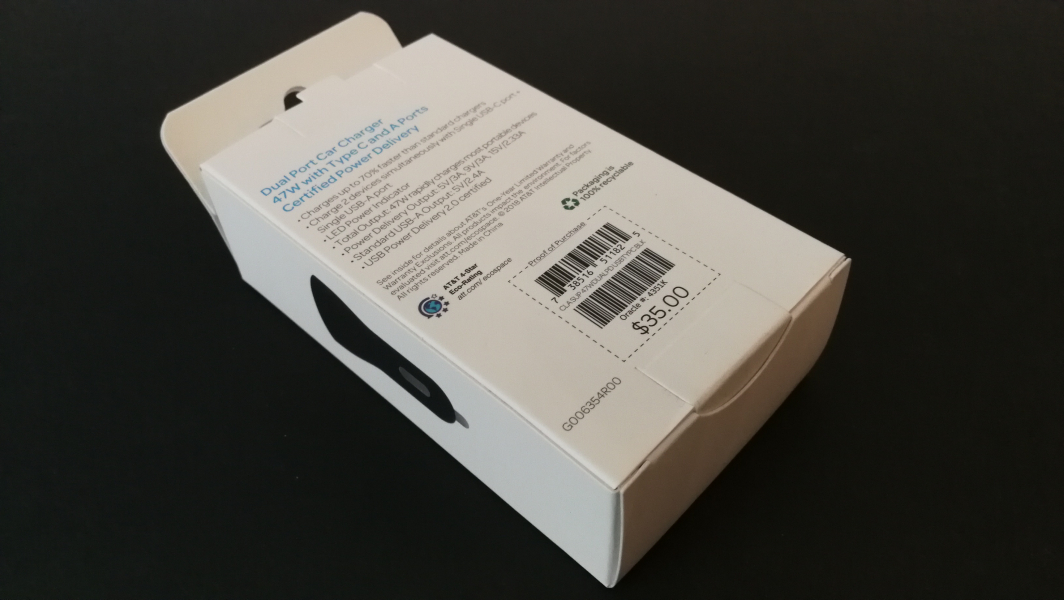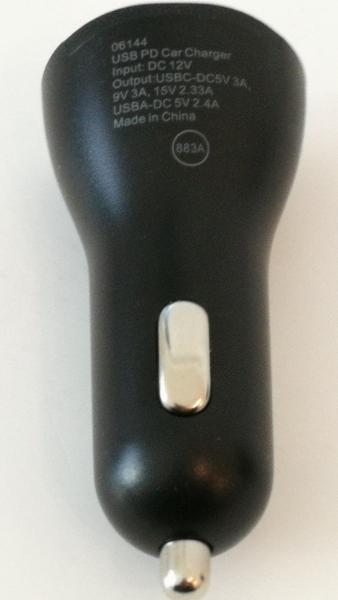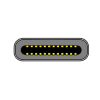Charging Technology Speed Performance Benchmarking
Chargers and Power Banks
Headphone & Speakers
Cases & Covers
Virtual Reality
Cables & Adapters
Media Player
Laptop
Tablet
Desktop
Cell Phone
Printers & Copiers
Memory Cards
TV
Computer Display
Game Console
Smart Home
Wearable Technology
Photo & Video Camera
Car Electronics
Car
Networking Equipment
Smart Toys
Home Audio & Video
Professional & Industrial
Storage Drive
Docking Station
Game Console Controllers
Set-top box
Keyboard, Mice, & Stylus
Portable Music Player
Computer Parts & Components
Cordless & Speakerphones
Projector
Software
Reporting
47W Dual Port Car Charger
by AT&T








A Quick Look at the AT&T 47W Dual Port Car Charger's Support of USB Power Delivery

AT&T sells various mobile accessories from popular brands as well as its own brand of chargers like the AT&T 18W Type-C Wall Charger and AT&T 47W Dual Port Car Charger. While both chargers support USB Power Delivery 2.0 technology for fast charging over the USB Type-C interface, the AT&T 47W Dual Port Car Charger has two USB ports to offer a total of 47 watts based charging.

The AT&T 47W Dual Port Car Charger supports 15 watts (5 volts @ 3 amps), 27 watts (9 volts @ 3 amps) and 35 watts (15 volts @ 2.33 amps) over its USB Type-C connector, allowing you to quickly charge tablets and smaller notebook computers like Apple's 11-inch iPad Pro (2018) and MacBook (Early 2016) and phones like the Apple iPhone XS Max or Android phones such as Google's Pixel 3 XL and the Samsung Galaxy S9+ using USB Power Delivery through the DC power outlet of your car.
Note if you need to charge your iPhone you need to use the Apple USB-C to Lightning Cable.
The AT&T 47W Dual Port Car Charger also provides a USB Type-A connector for 12 watts (5 volts @ 2.4 amps) legacy charging for USB peripherals.

Given that the AT&T 47W Dual Port Car Charger has been certified not only by AT&T but also USB-IF through the USB certification logo shown on the box meaning that the charger should have a high degree of compatibility to charge most other USB compliant devices.



The AT&T 47W Dual Port Car Charger conveniently allows you to charge two devices simultaneously in your car but in case you're looking for a single port ac wall charger good enough to charge your phone or tablet, you may also consider the AT&T 18W Type-C Wall Charger (click here for review).
Using the USB Power Test App from Granite River Labs with the Granite River Labs USB Power Delivery Compliance C2 Tester, we performed the following tests for the AT&T 47W Dual Port Car Charger.
The USB Power Test App first negotiates a power contract for every PDO supported by the AT&T charger, and increases the load gradually to find the threshold where over current protection (OCP) kicks in and voltage and current start to drop for safety reasons.
The USB Power Test App reports out all the PDO's supported by the AT&T charger and their OCP thresholds. OCP thresholds for the AT&T charger are set at about 24-135% above the maximum current levels for the fixed PDO's.
| PDO | OCP (A) |
|---|---|
| PDO#1 Fixed: 5V 3A | 3.73 |
| PDO#2 Fixed: 9V 3A | 5.47 |
| PDO#3 Fixed: 15V 2.33A | 5.47 |
The USB Power Test App from Granite River Labs also produces an I-V curve which graphically shows the relationship between voltage and current for each PDO. We can observe as the current increases beyond the OCP threshold, the voltage immediately shuts off.
Since the AT&T 47W Dual Port Car Charger is a multi port charger, the USB Power Test App can be used to determine whether each output port of the charger is able to supply power independently. For every PDO supported by the AT&T charger, the USB Power Test App increases the load gradually for both the USB Type-C and Type-A ports to detect any power loss at the highest load limit for each port.
USB Type-C Port
USB Type-A Port
The USB Power Test App reports out the voltage, current and load limits for all the PDO's supported by the AT&T charger for each port.
| Port1 PDO | Port2 PDO | Port1 (V) | Port1 (A) | Port1 Loading(%) | Port2 (V) | Port2 (A) | Port2 Loading(%) |
|---|---|---|---|---|---|---|---|
| PDO#1 Fixed: 5V 3A | 5.03 | 2.97 | 100% (15W) | ||||
| PDO#1 Fixed: 5V 3A | PDO#1 Fixed: 5V 1.5A | 5 | 2.98 | 99.59% | 5.16 | 1.51 | |
| PDO#2 Fixed: 9V 3A | 8.98 | 2.98 | 100% (26.8W) | ||||
| PDO#2 Fixed: 9V 3A | PDO#1 Fixed: 5V 1.5A | 8.96 | 2.97 | 99.66% | 5.16 | 1.5 | |
| PDO#3 Fixed: 15V 2.33A | 14.93 | 2.32 | 100% (34.6W) | ||||
| PDO#3 Fixed: 15V 2.33A | PDO#1 Fixed: 5V 1.5A | 14.91 | 2.33 | 100.49% | 5.14 | 1.5 | |
| PDO#1 Fixed: 5V 1.5A | 5.1 | 1.5 | 100% (7.7W) | ||||
| PDO#1 Fixed: 5V 3A | PDO#1 Fixed: 5V 1.5A | 5 | 2.98 | 5.16 | 1.51 | 101.42% | |
| PDO#2 Fixed: 9V 3A | PDO#1 Fixed: 5V 1.5A | 8.96 | 2.97 | 5.16 | 1.5 | 100.93% | |
| PDO#3 Fixed: 15V 2.33A | PDO#1 Fixed: 5V 1.5A | 14.91 | 2.33 | 5.14 | 1.5 | 100.67% |
Using the USB Power Delivery Compliance C2 Tester from Granite River Labs to run just a subset of the full USB Power Delivery compliance test suite for the AT&T 47W Dual Port Car Charger, some compliance failures were observed even though the charger claims it is USB-IF certified so just be careful when using this charger.
USB-IF High Level Mapping Summary
Sl No
|
Test Category
|
Test Group Description
|
Test Result
|
|---|---|---|---|
1
|
PHY_PRIMARY_TX
|
BMC Physical Layer Transmitter
|
PASS
|
2
|
PHY_PRIMARY_RX
|
BMC Physical Layer Receiver
|
PASS
|
3
|
PHY_PRIMARY_MISC
|
BMC Physical Layer Miscellaneous
|
PASS
|
4
|
PROT_PRIMARY
|
Protocol Specific Primary
|
FAIL
|
5
|
POWER_PRIMARY
|
Power Source/Sink Primary
|
FAIL
|
Result Summary
Sl No
|
Test ID
|
Test Name
|
Test Result
|
|---|---|---|---|
1
|
TDA.2.1.1.1
|
TDA.2.1.1.1 BMC PHY TX EYE
|
PASS
|
2
|
TDA.2.1.1.2
|
TDA.2.1.1.2 BMC PHY TX BIT
|
PASS
|
3
|
TDA.2.1.2.2
|
TDA.2.1.2.2 BMC PHY RX INT REJ
|
PASS
|
4
|
TDA.2.1.2.1
|
TDA.2.1.2.1 BMC PHY RX BUSIDL
|
PASS
|
5
|
TDA.2.1.3.1
|
TDA.2.1.3.1 BMC PHY TERM
|
PASS
|
7
|
TDA.2.2.1
|
TDA.2.2.1 BMC PROT SEQ GETCAPS
|
PASS
|
11
|
TDA.2.2.7
|
TDA.2.2.7 BMC PROT BIST NOT 5V SRC
|
FAIL
|
13
|
TDA.2.2.9
|
TDA.2.2.9 BMC PROT GSC REC
|
FAIL
|
15
|
TDA.2.3.2.1
|
TDA.2.3.2.1 POW SRC TRANS P PC
|
FAIL
|
BMC Eye Diagram
View Full Article
USB PD Charging Technologies & Battery Life Benchmarking
Featured Products
 GTrusted
GTrusted


































